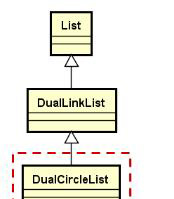如何用Linux内核链表来实现DTLib中的双向循环链表-创新互联
本篇内容介绍了“如何用Linux内核链表来实现DTLib中的双向循环链表”的有关知识,在实际案例的操作过程中,不少人都会遇到这样的困境,接下来就让小编带领大家学习一下如何处理这些情况吧!希望大家仔细阅读,能够学有所成!

继承关系如下图所示

下来我们来讲讲它的设计思路:数据结点之间在逻辑上构成双向循环链表,头结点仅用于结点的定位。如下图所示

实现思路:
1、通过模板定义 DualCircleList 类。继承自 DualLinkList 类;
2、在 DualCircleList 内部使用 Linux 内核链表进行实现;
3、使用 struct list_head 定义 DualCircleList 的头结点;
4、特殊处理:循环遍历时忽略头结点
实现要点:
1、通过 list_head 进行目标结点定位(position(i));
2、通过 list_entry 将 list_head 指针转换为目标结点指针;
3、通过 list_for_each 实现 int find(const T& e) 函数;
4、遍历函数中的 next() 和 pre() 需要考虑跳过头结点
下来我们来看看基于 Linux 内核链表的双向循环链表是怎样写的
DualCircleList 源码
#ifndef DUALCIRCLELIST_H
#define DUALCIRCLELIST_H
#include "DualLinkList.h"
#include "LinuxList.h"
namespace DTLib
{
template < typename T >
class DualCircleList : public DualLinkList<T>
{
protected:
struct Node : public Object
{
list_head head;
T value;
};
list_head m_header;
list_head* m_current;
list_head* position(int i) const
{
list_head* ret = const_cast<list_head*>(&m_header);
for(int p=0; p<i; p++)
{
ret = ret->next;
}
return ret;
}
int mod(int i) const
{
return (this->m_length == 0) ? 0 : (i % this->m_length);
}
public:
DualCircleList()
{
this->m_length = 0;
this->m_step = 1;
m_current = NULL;
INIT_LIST_HEAD(&m_header);
}
bool insert(const T& e)
{
return insert(this->m_length, e);
}
bool insert(int i, const T& e)
{
bool ret = true;
Node* node = new Node();
i = i % (this->m_length + 1);
if(node != NULL)
{
node->value = e;
list_add_tail(&node->head, position(i)->next);
this->m_length++;
}
else
{
THROW_EXCEPTION(NoEnoughMemoryException, "No memory to insert new element ...");
}
return ret;
}
bool remove(int i)
{
bool ret = true;
i = mod(i);
ret = ((0 <= i) && (i < this->m_length));
if( ret )
{
list_head* toDel = position(i)->next;
if( m_current == toDel )
{
m_current = toDel->next;
}
list_del(toDel);
this->m_length--;
delete list_entry(toDel, Node, head);
}
return ret;
}
bool set(int i, const T& e)
{
bool ret = true;
i = mod(i);
ret = ((0 <= i) && (i < this->m_length));
if( ret )
{
list_entry(position(i)->next, Node, head)->value = e;
}
return ret;
}
T get(int i) const
{
T ret;
if( get(i, ret) )
{
return ret;
}
else
{
THROW_EXCEPTION(IndexOutOfBoundsException, "Invaild parameter i to get element ...");
}
}
bool get(int i, T& e) const
{
bool ret = true;
i = mod(i);
ret = ((0 <= i) && (i < this->m_length));
if( ret )
{
e = list_entry(position(i)->next, Node, head)->value;
}
return ret;
}
int find(const T& e) const
{
int ret = -1;
int i = 0;
list_head* slider = NULL;
list_for_each(slider, &m_header)
{
if( list_entry(slider, Node, head)->value == e )
{
ret = i;
break;
}
i++;
}
return ret;
}
int length() const
{
return this->m_length;
}
void clear()
{
while( this->m_length > 0 )
{
remove(0);
}
}
bool move(int i, int step = 1)
{
bool ret = (step > 0);
i = mod(i);
ret = ret && ((0 <= i) && (i < this->m_length));
if( ret )
{
m_current = position(i)->next;
this->m_step = step;
}
return ret;
}
bool end()
{
return (m_current == NULL) || (this->m_length == 0);
}
T current()
{
if( !end() )
{
return list_entry(m_current, Node, head)->value;
}
else
{
THROW_EXCEPTION(INvalidOPerationException, "No value at current position ...");
}
}
bool next()
{
int i = 0;
while( (i < this->m_step) && !end() )
{
if( m_current != &m_header )
{
m_current = m_current->next;
i++;
}
else
{
m_current = m_current->next;
}
}
if( m_current == &m_header )
{
m_current = m_current->next;
}
return (i == this->m_step);
}
bool pre()
{
int i =0;
while( (i < this->m_step) && !end() )
{
if( m_current != &m_header )
{
m_current = m_current->next;
i++;
}
else
{
m_current = m_current->prev;
}
}
if( m_current == &m_header )
{
m_current = m_current->next;
}
return (i == this->m_step);
}
~DualCircleList()
{
clear();
}
};
}
#endif // DUALCIRCLELIST_H下来我们写点测试代码看看上面的代码有没有问题
main.cpp 源码
#include <iostream>
#include "DualCircleList.h"
using namespace std;
using namespace DTLib;
int main()
{
DualCircleList<int> d1;
for(int i=0; i<5; i++)
{
d1.insert(0, i);
d1.insert(0, 5);
}
cout << "begin" << endl;
d1.move(d1.length()-1);
while( d1.find(5) != -1 )
{
if( d1.current() == 5 )
{
cout << d1.current() << endl;
d1.remove(d1.find(d1.current()));
}
else
{
d1.pre();
}
}
cout << "end" << endl;
for(int i=0; i<d1.length(); i++)
{
cout << d1.get(i) << endl;
}
return 0;
}我们先来分析下,在插入 i 后,随后便插入 5。先打印出 5 个 5,随后删除这 5 个数,然后在打印出剩下的 4 ~ 0。看看结果是否如我们所分析的那样

“如何用Linux内核链表来实现DTLib中的双向循环链表”的内容就介绍到这里了,感谢大家的阅读。如果想了解更多行业相关的知识可以关注创新互联网站,小编将为大家输出更多高质量的实用文章!
另外有需要云服务器可以了解下创新互联scvps.cn,海内外云服务器15元起步,三天无理由+7*72小时售后在线,公司持有idc许可证,提供“云服务器、裸金属服务器、高防服务器、香港服务器、美国服务器、虚拟主机、免备案服务器”等云主机租用服务以及企业上云的综合解决方案,具有“安全稳定、简单易用、服务可用性高、性价比高”等特点与优势,专为企业上云打造定制,能够满足用户丰富、多元化的应用场景需求。
分享名称:如何用Linux内核链表来实现DTLib中的双向循环链表-创新互联
当前地址:https://www.cdcxhl.com/article6/dsdcig.html
成都网站建设公司_创新互联,为您提供电子商务、外贸建站、网站导航、域名注册、网站维护、全网营销推广
声明:本网站发布的内容(图片、视频和文字)以用户投稿、用户转载内容为主,如果涉及侵权请尽快告知,我们将会在第一时间删除。文章观点不代表本网站立场,如需处理请联系客服。电话:028-86922220;邮箱:631063699@qq.com。内容未经允许不得转载,或转载时需注明来源: 创新互联

- 如何提高移动网站建设应用程序的保留率? 2022-08-24
- 移动网站建设需要注意哪些? 2013-11-20
- 移动网站建设更多优势 2022-04-15
- 移动网站建设支付页面设计:给用户一个熟悉的味道 2023-03-05
- 移动网站建设如何做好极简设计 2022-08-20
- 移动网站建设的要点有哪些? 2016-11-01
- 成都移动网站建设注意事项有哪些? 2020-08-18
- 创新互联谈谈移动网站建设的必要性 2015-01-19
- 移动网站建设会给用户带来什么样的影响? 2017-01-25
- 为什么说当下企业移动网站建设势在必行? 2022-10-16
- 企业移动网站建设需要注意哪些用户反感的设定? 2022-10-25
- 移动网站建设如何处理好细节 2022-03-17